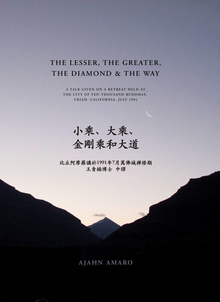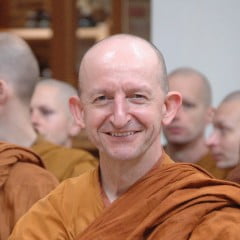HISTORICALLY THERE HAVE BEEN differences of opinion about the relative merits of Theravada and Mahayana Buddhism and, if you read much of the literature, they would seem to be quite divergent in their approaches toward Buddhist practice – yet there also seem to be some tremendous affinities.
When I arrived at the International Forest Monastery in Thailand, I had never read any Buddhist books and I wasn’t actually in search of becoming a Buddhist monk. I was a wanderer, a free-lance spiritual seeker, and I just happened to turn up at this forest monastery that Ajahn Sumedho had established a couple of years before, basically as a place for a free meal and a roof over my head for a few nights. Little did I expect, some twelve or thirteen years later, that I would be doing what I am doing now. But when I went there and asked the monks about Buddhism, to explain things a little bit for me so that I could get a feel for what their life was about, the first thing one of them did was to give me a copy of a book of talks by a Zen Master, and he said, ‘Don’t bother trying to read the Theravada literature; it’s terribly boring, very dry. Read this, it is pretty much the same thing that we’re doing, and it will give you a sense of what our practice is about.’ And I thought, ‘Well, obviously these guys are not too hung up on their tradition.’ The book was Zen Mind, Beginner’s Mind.
So, one could see right from the beginning that, even though there is a strength to the particular form within any Buddhist country, one is not necessarily constricted or limited by that. I was there for months before I even heard of ‘Theravada’ and ‘Mahayana,’ let alone the differences of opinion between them. It seemed that when you actually lived the life there really wasn’t any great disparity, but if you thought about it a lot, and if you were the kind of person who wrote histories and books and had got into the political side of religious life, then that was where the divergences occurred.
I have heard Ajahn Sumedho recount a few times over the years that, for the first year of his monastic life, he had been practising using the instructions from a Ch’an meditation retreat given by the Ven. Master Hsü Yün, and that he had used the Dharma talks from that retreat given in China as his basic meditation instruction. When he went to Wat Pah Pong, Ajahn Chah asked him what kind of meditation he had been doing, at first he thought, ‘Oh no, he’s going to get me to give this up and do his method.’ But, when Ajahn Sumedho described what he had been doing and mentioned that it had had excellent results, Ajahn Chah said, ‘Oh, very good, just carry on doing that.’
So, one sees that there is a very strong unity of purpose; even though there might be historical differences between the two traditions, they are very much in accordance with each other. And one begins to see what the different Buddhist traditions are talking about. They get sectioned out into Hinayana or Mahayana or Vajrayana, as different types of Buddhist practice, but they are basically just different labels which are talking about attitudes of mind and, when the traditions are used wisely, then they will address all aspects of our mind, from the most selfish and mundane to the most exalted. They address all the different levels of our life, and it’s only when they are not understood, when people take them as fixed positions, that there is any conflict amongst them.















































































